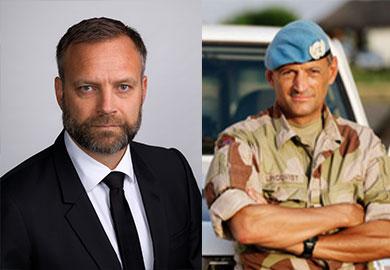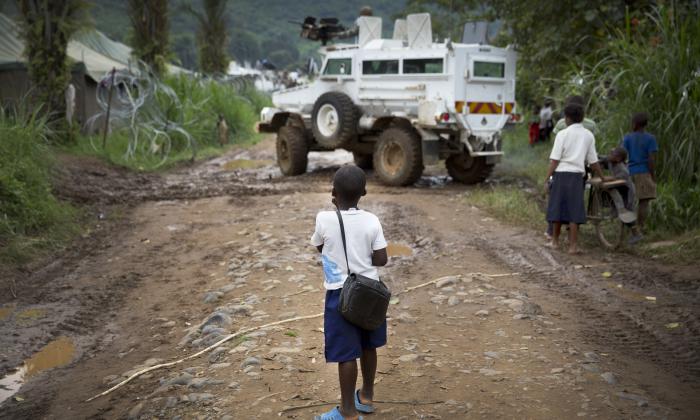Advanced distributed learning for peace operations
Supporting the implementation of mandated tasks through digital technologies | Dr. Stian Kjeksrud & Petter LindqvistEven before the current pandemic, there was a critical need to develop new, digitized and distributed solutions to education and training for peace operations. For the near future, travel restrictions and fiscal constraints will most likely further increase this need. The Norwegian Defence University College (NDUC) has recently developed an innovative – stand-alone – e-learning programme on human security and the role of the military, which fills a gap in existing education by answering the critical question of «when to do what» when perpetrators target civilians in armed conflict.
Delivering protection of civilians
Protection of civilians (POC) has been an integral facet of peacekeeping since 1999. To date, sixteen UN missions have been mandated to protect civilians from physical violence of which seven are active today. Currently, the UN Security Council prioritizes protection before other tasks. Some would even claim that protection is now largely synonymous with peacekeeping. Since the spectacular protection failures of the mid 1990s, there has been significant policy and conceptual developments in the UN, often driven by innovation in the field. But it still difficult to know when to do what in order to enhance civilian security without causing more harm in the process. For military planners and practitioners, these complex issues can lead to much frustration and indeed critical voices from outside observers.
Military force has proven quite useful in protecting civilians from violence.
Contrary to some of the criticism of the failure to succeed with this “mission impossible”, military force has proven quite useful in protecting civilians from violence. Recent insights point to significant conflict reducing effects of large uniformed deployments. Moreover, UN troops succeed more often than previously thought when they intervene to protect. And yet, more can be done to increase the chance of success. One way is to prepare uniformed personnel systematically for protecting civilians – a new task for most militaries in its iteration in peace operations. One way forward is therefore to further improve the pre-deployment preparation and training on POC.
Bridging the gap to reality
How then can digital technologies help overcome the gap from a clear conceptual understanding of POC challenges to the murky reality of meeting those challenges during deployment in the field? This consideration led NDUC to explore digital technology for military education and training. By developing an e-learning programme − based on a so-called «flipped classroom» approach where students are exposed to key themes through short video-lectures prior to attending traditional in-person or digital lectures or Q&A-sessions – NDUC can now provide advanced distributed learning to a larger audience.
The target audience are military staff officers engaged in planning, implementing and assessing operations seeking to protect civilians from violence, although the e-learning programme is useful for anyone seeking to understand the role, limitations and utility of force in protecting civilians from violence. The programme is already in use as part of the Master’s degree education at the Norwegian Defence Command and Staff College and forms part of the curriculum at the UN/NATO Protection of Civilians course held at the Finnish Defence Forces International Centre (FINCENT).
Through 12 short video lessons students are introduced to four main topics:
- Understanding trends in armed conflict,
- Understanding threats to civilians,
- Establishing physical security, and
- Assessing protection of civilians.
Each lesson contains real-life archive footage of former armed conflicts. Students are encouraged to go through the lessons chronologically, but it is possible to watch each separately for specific purposes. Key take-aways are included at the end of each lesson. The video lessons are based on research conducted at the NDUC and the Norwegian Defence Research Establishment since 2008. They provide a systematic and threat-based approach to protection of civilians tailored to standard military planning processes. The insights provided are relevant for all types of military operations, regardless of institutional framework.
Extended reality on the horizon
In the near future, NDUC will develop an educational programme based on Extended Reality (XR) technology, to bring planners closer to the protection challenges met in operations where civilians are targeted with violence. Both Extended Reality and e-learning approaches are examples of utilizing digital technology to prepare uniformed personnel for challenging tasks. The recently developed e-learning programme can be accessed and used without cost by all troop- and police-contributing countries (TCC/PCCs), and do not require dedicated staff for follow up, although each lesson invites to further discussion. For the future XR-project, an expected outcome is that the software and technological solutions can be used to educate and train officers and troops on a range of topics. It is quite costly to develop such innovative educational programmes, but once produced there is a significant potential to scale down the cost of travelling and human resources involved in teaching.
XR-technology allows for easy adaptation to national doctrines while still adhering to the bedrock principles of peacekeeping and UN policies.
Equally important is the benefit this kind of immersive training carries by bringing the users into the conflict environment to experience relevant challenges in a systematic manner. In addition, XR-technology allows for easy adaptation to national doctrines while still adhering to the bedrock principles of peacekeeping and UN policies. Through its intuitive and real-life learning experience, the XR-project will also examine the effectiveness of learning in areas, where there is a lack of adequate educational programmes. This includes protection of civilians, but other examples may be the use of peacekeeping intelligence and UN logistics.
An opportunity for digital collaboration
Finally, to split the costs and to explore the inherent potential of new technologies in peacekeeping training, one idea would be to start linking up initiatives in different countries through a virtual peace operations training academy. Through such concerted efforts, the wider peacekeeping community would provide much needed knowledge for those set to implement ambitious mandates, bringing UN peace operations a few steps closer to successful outcomes.
- You can access the NDUC e-learning programme here.
- NDUC encourages feedback on the e-learning programme. Please contact: Colonel Petter Lindqvist & Stian Kjeksrud
Download article
IMAGES
- Authors | Dr. Stian Kjeksrud priv., Colonel Petter Lindqvist priv.
- Children in front of UN vehicle | UN Photo, Sylvain Liechti
- Video | NODEFIC, protectingcivilians.com

